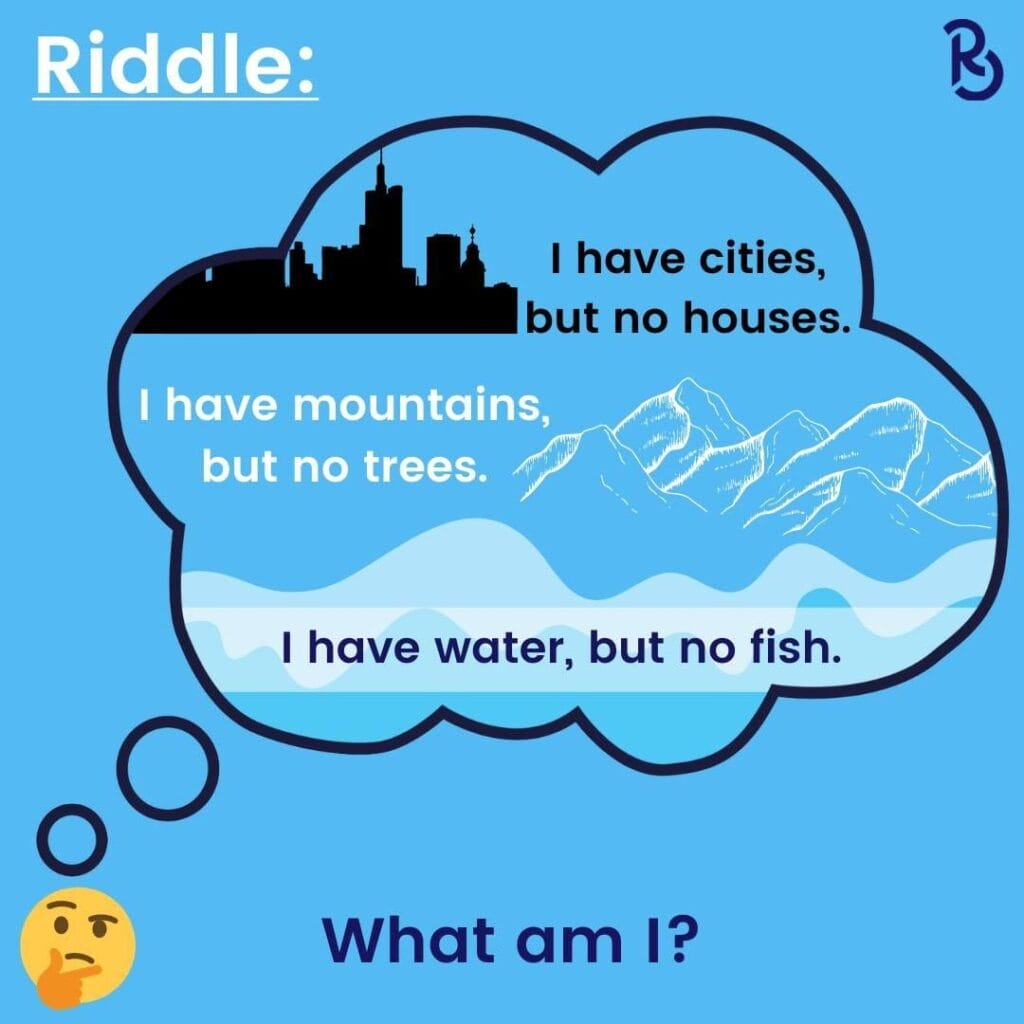Introduction
We explore the famous riddle:
I have cities, but no houses. I have mountains, but no trees. I have water, but no fish. What am I?”
This riddle appears simple yet puzzles many. We will reveal the answer, analyze each clue in detail, discuss its variations, and provide the best explanations. Our aim is to give you the most thorough understanding possible of “I have cities but no houses riddle” so that you can recognize and appreciate its cleverness—and impress others with your insight.
What Is the Correct Answer?
The answer to this riddle is a map.
A map shows representations of cities, mountains, forests, water bodies, etc., but not the literal items such as houses, trees, or fish. It is symbolic rather than physical, which is why it perfectly matches the riddle’s description.
Detailed Analysis of Each Clue
We break down each part of the riddle to reveal how “map” fits all of them, and why alternative answers usually fail.
| Clue | Literal Interpretation | Map Interpretation |
|---|---|---|
| “I have cities, but no houses.” | Suggests cities exist, but no homes are present | On a map, cities are marked by names or icons; it does not show individual houses or buildings. |
| “I have mountains, but no trees.” | Implies mountains should have trees, but here there are none | Maps show mountainous terrain often with symbols or shading; trees (individual vegetation) are omitted. |
| “I have water, but no fish.” | Water bodies normally host fish, but in this description, no fish exist | Maps illustrate lakes, rivers, seas, but of course, there are no fish in those symbolized waters. |

Each line invites the reader to separate representation from reality, which is the core trick of the riddle.
Why This Riddle Is Especially Effective
- Symbol vs Reality: The riddle forces you to think in abstraction. We usually assume “cities,” “mountains,” “water” are real, living entities; here they are symbolic.
- Expectation Subversion: It subverts our expectations. Normally, houses go with cities, trees with mountains, fish with water. Removing those expected elements makes us pause.
- Simplicity Plus Depth: Its language is simple, accessible to children, yet the logic has enough depth to appeal to adult thinkers.
- Universality: Cultures everywhere use maps; the concept translates across languages. That makes this riddle widely recognized.
Variations of the Riddle
Over time, versions of this riddle have appeared with slightly different wording:
- “I have cities but no houses, forests but no trees, rivers but no water.”
- “I have cities, but no houses; I have mountains, but no trees; I have water, but no fish.”
These variations maintain the same structure: juxtaposing familiar geographic features with the unexpected absence of what one assumes.
Common Alternative Guesses & Why They Are Wrong
Here are some wrong but common guesses, and why they fail:
- Globe: Similar to a map, but a globe is a physical sphere. The riddle implies a flat, symbolic form.
- Atlas: A collection of maps; the singular “map” is a more precise fit.
- Imaginary world / fantasy realm: Too vague, they don’t match the exact wording of the riddle.
Only map fits every line exactly: cities but no houses; mountains without trees; water without fish.
Why Stars Twinkle A Class 10 Science Explanation
Origins and Cultural Presence
This riddle is widespread in English-language traditions and is often used in classrooms to teach critical thinking. It has been passed down in oral storytelling, appeared in puzzle books, and now circulates widely on the internet and social media. Its strength lies in being both simple to state and clever in meaning, making it memorable across generations.
How to Use This Riddle
We suggest these contexts for this riddle:
- Educational settings: Encourage students to think abstractly and distinguish between reality and representation.
- Icebreakers or puzzles: A fun way to engage audiences in seminars or gatherings.
- Language learning: Helpful for teaching metaphors, symbolic thinking, and the idea of representation.
Other Riddles with Similar Structure
This riddle belongs to a family of riddles that juxtapose what is with what isn’t, to force the mind beyond literal thinking. Examples include:
- “What can travel around the world while staying in a corner?” → A stamp.
- “What has keys but can’t open locks?” → A piano.
Like our riddle, these use expectation and absence to produce the twist.
Answer in Short Form
- Answer: A map.
- Because: A map displays representations of cities, mountains, and water, without the real houses, trees, or fish.
Conclusion
We have examined the riddle “I have cities but no houses. I have mountains but no trees. I have water but no fish.” in full. The correct answer is a map, an object that symbolically represents the real world without including all its physical content. Each clue cleverly removes what we expect—houses, trees, fish—so that the answer demands abstract thinking rather than literal observation. We explored each line, why other guesses fail, variations of the riddle, and its educational and cultural significance. By knowing this riddle’s structure and meaning, we can both solve it quickly ourselves and explain it clearly to others. There is deep satisfaction in such riddles because they shift perspective: one sees not the object itself, but how we choose to depict it. Share this riddle, challenge others, and enjoy the moment when someone discovers the clever twist hidden within it.
People Also Ask
- What is the meaning behind “I have cities but no houses”?
It means that the riddle refers to a representation (a map), not reality. Cities are shown symbolically without real houses. - Why isn’t the answer “globe” or “atlas”?
Although close, those answers either don’t fit all clues precisely or include extra features that violate the riddle’s constraints. “Map” is the most precise. - Can there be more than one correct answer?
Typically, riddles like this have one best answer. While creative guesses are encouraged, only “map” satisfies every clue in the riddle without contradiction. - Where did this riddle originate?
The precise origin is unclear, but it has long been part of puzzle traditions, educational activities, and oral storytelling before becoming popular online. - How can one come up with riddles like this?
Combine familiar scenarios (cities, trees, water) with what they lack, then make that gap the central puzzle. Use symbolism and surprise by omitting something expected.


